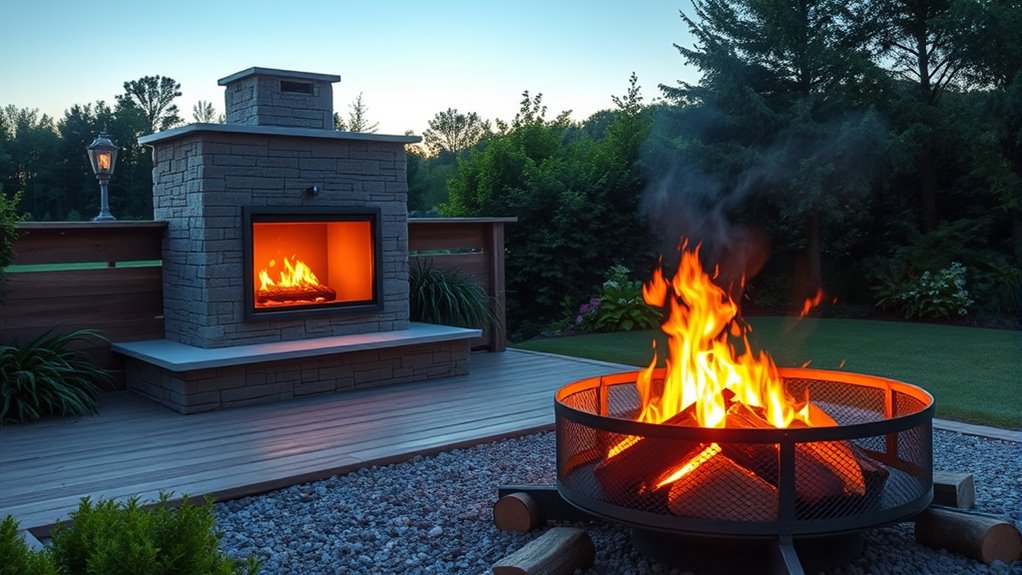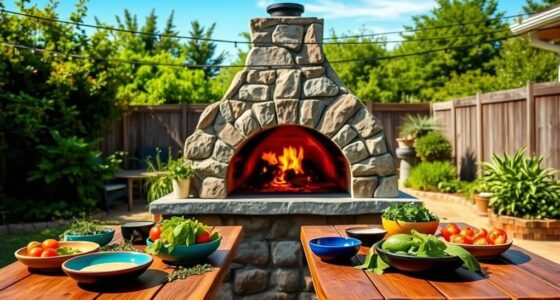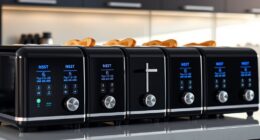Outdoor fireplaces are generally safer than fire pits because their enclosed design helps contain flames and sparks, reducing the risk of accidental fires. Fire pits, especially open ones, allow sparks and embers to escape, which can be hazardous in windy conditions or near flammable materials. To make the best choice and understand safety tips for each, keep exploring the differences and precautions for a safer outdoor experience.
Key Takeaways
- Enclosed outdoor fireplaces generally offer safer operation by containing flames and sparks, reducing fire hazards.
- Fire pits are more exposed to wind, increasing the risk of sparks and embers escaping, especially with wood burning.
- Electric outdoor fireplaces are the safest option, eliminating open flames and smoke altogether.
- Proper placement at least 9-10 feet from flammable structures is critical for both fire pits and fireplaces.
- Gas fire pits are safer than wood-burning models but still require careful monitoring to prevent leaks and fires.

In contrast, fire pits are typically open at the top, allowing flames and sparks to roam freely, especially with wood-burning models. This open design increases the risk of sparks escaping, so using spark screens or glass windshields is highly recommended. Fire pits often sit directly on the ground, which can scorch the surface underneath if not placed on a stable, non-combustible base. Their open structure makes them more susceptible to wind, which can fan flames and blow sparks into nearby flammable materials. Safety guidelines specify that fire pits should be installed at least 9 to 10 feet away from any flammable structures or vegetation. Proper placement is essential to prevent accidental fires, and avoiding prevailing winds can reduce hazards and improve heat retention. Cookies categories and user consent management are crucial for ensuring safe and compliant use of outdoor heating appliances. Fuel type plays an indispensable role in safety considerations. Wood-burning fire pits produce the highest risk for sparks and flying embers, demanding extra caution and protective accessories. Gas fire pits are considered safer because they don’t generate sparks but require vigilant monitoring to prevent gas leaks or accidental fires if left on. Electric outdoor fireplaces provide the safest option, with no open flames or smoke, making them ideal for families with young children or pets. The heat output varies based on fuel type, with fireplaces offering longer-lasting warmth due to their contained design, while fire pits provide more open heat, which dissipates quickly, especially on windy days. Overall, fireplaces with enclosed designs and proper safety features tend to offer better control and reduce the likelihood of accidents, making them a safer choice for many homeowners.
Frequently Asked Questions
Are Outdoor Fireplaces More Energy-Efficient Than Fire Pits?
You’re wondering if outdoor fireplaces are more energy-efficient than fire pits. Generally, fireplaces contain heat better with enclosed designs, helping you retain warmth longer and use fuel more efficiently. Gas-fired options, especially, burn cleaner and control flames better, saving fuel and reducing waste. Fire pits disperse heat more widely and often require more fuel and maintenance, making them less energy-efficient overall. So, fireplaces usually offer better energy savings for outdoor heating.
Can Outdoor Fireplaces Be Used Safely During Windy Conditions?
You can use outdoor fireplaces safely in windy conditions if you take proper precautions. Keep wind guards or shields in place, avoid burning easily dispersed materials, and maintain at least 10 feet from flammable objects. Always monitor weather conditions closely, never leave the fire unattended, and have firefighting tools nearby. Control the fire size and extinguish it completely if wind intensifies. These steps help prevent accidents and guarantee safety.
What Is the Maintenance Difference Between Fireplaces and Fire Pits?
Imagine you’ve just hosted a cozy evening around your outdoor fireplace, and now it’s time to clean. You’ll need to regularly remove ash and debris from the firebox, inspect the chimney for blockages, and clean metal parts and stone surfaces. Fire pits, on the other hand, require simpler maintenance—mostly just removing ashes and water, and checking the base for stability. Both benefit from annual professional inspections, but fireplaces generally need more frequent upkeep.
Are There Specific Safety Codes for Outdoor Fireplaces?
You should know that specific safety codes govern outdoor fireplaces. These include the International Fire Code, which requires recreational fires to be at least 25 feet from structures and portable fireplaces to be 15 feet away, with some exceptions. NFPA standards emphasize proper chimney installation and venting. Always follow manufacturer instructions, obtain necessary permits, and make certain your fireplace is installed and maintained according to local codes to stay safe.
How Do Costs Compare for Installation and Operation?
When comparing costs, you’ll find fire pits are generally cheaper to install and operate than outdoor fireplaces. Fire pits often cost between $1,500 and $5,500 for installation, with lower ongoing expenses, especially if wood-burning. Outdoor fireplaces typically cost $5,000 to $10,000 or more to install and tend to have higher operational costs due to their durable construction and utility bills. Your choice depends on your budget and long-term maintenance plans.
Conclusion
Ultimately, both outdoor fireplaces and fire pits can be safe if you follow proper guidelines. You might think fireplaces are safer because they’re enclosed, but a well-built fire pit with a clear boundary can be just as secure. The truth is, safety depends on your setup and precautions—never leave a fire unattended or ignore local regulations. With responsible use, you can enjoy cozy evenings outside without worry, making your choice a matter of style rather than safety.









